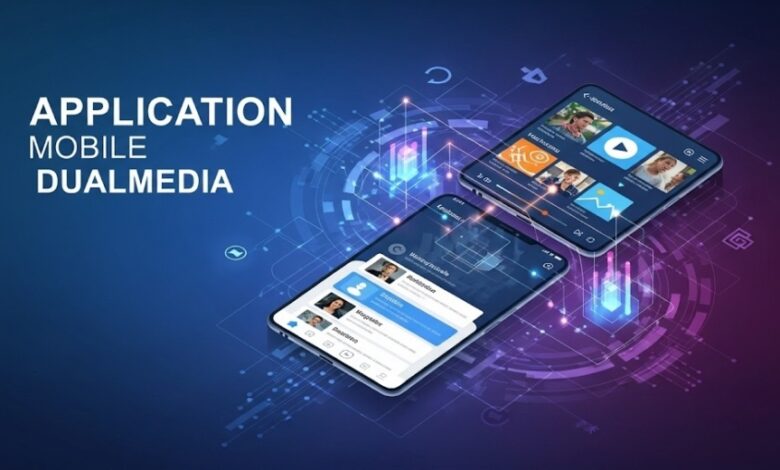Application Mobile DualMedia: The Next Big Thing in Mobile Experiences

What is Application Mobile DualMedia?
Application Mobile DualMedia “Application Mobile DualMedia” (often shortened to DualMedia apps) refers to mobile applications built to integrate multiple media types and deliver those across different platforms, while maintaining consistency, performance, and high-quality user experience.
- First, it means combining media: text, images, video, audio, animations, maybe interactive content—within a single app. Not just an image gallery or a video player, but a dynamic mix, where media types support one another.
- Second, DualMedia implies cross-platform compatibility: iOS, Android, perhaps web/mobile web, maybe even desktop or embedded environments. The same underlying application logic, media pipelines, UI/UX fundamentals adapt to each platform without major trade-offs.
- Third, it’s about user experience: responsiveness, adaptability (different screen sizes, network speeds), offline support, and smooth transitions between media. Users shouldn’t feel “this part is mobile” vs “this is web” — it should flow seamlessly.
This concept isn’t entirely new—but what makes Application Mobile DualMedia: The Next Big Thing in Mobile Experiences DualMedia distinct is how deeply the integration goes. It’s not just adding video to text; it’s building a media-engine as part of the app architecture, making content modular, adaptive, and media-aware.
Why We’re Seeing a Surge in DualMedia Apps

There are multiple driving forces behind the growing popularity of Application Mobile DualMedia:
- Consumer expectations are evolving. People spend more time on mobile devices, expect rich content, and don’t want to switch apps to see different formats. If one moment you’re reading text, the next you want video or audio, perhaps interactive graphics. DualMedia supports that flow.
- Cost and time pressures on developers & businesses. Maintaining separate apps (for iOS, Android, web) with different media presentation layers is expensive. Application Mobile DualMedia: The Next Big Thing in Mobile Experiences DualMedia helps consolidate work: shared backends, shared media assets, cross-platform frameworks reduce duplication.
- Network improvements & device capabilities. With faster mobile networks (4G, 5G, WiFi everywhere) and more powerful phones/tablets, devices can handle richer media (higher bitrate video, smoother animations, AR/VR content). This technical readiness makesApplication Mobile DualMedia: The Next Big Thing in Mobile Experiences DualMedia more feasible.
- Content creators’ need for storytelling flexibility. Whether for education, marketing, journalism, or entertainment, stories are more persuasive when multiple media are used—video, audio, interactive charts. Application Mobile DualMedia: The Next Big Thing in Mobile ExperiencesDualMedia lets creators craft richer narratives without forcing the user out of their mobile context.
Key Features of DualMedia Applications
If you were building or evaluating a Application Mobile DualMedia: The Next Big Thing in Mobile Experiences DualMedia app, here are features you’d expect or aim for:
Multi-format content integration
- The ability to include and coordinate text, video, audio, animations, infographics etc. in the app, with smooth transitions.
- Media should be optimised (bitrate, resolution) depending on device & network. For example, buffering video on slow networks, or providing low-bandwidth fallback.
- Support for interactive media: quizzes inside videos, interactive graphics, perhaps AR/VR components.
Cross-platform & adaptive design
- Use of cross-platform frameworks (React Native, Flutter, or similar) or modular architectures that share code/media assets across platforms.
- Adaptive UIs: layout changes, orientations, resolution differences all handled gracefully. The app should also detect the environment (mobile data vs WiFi, battery state, etc.) and adapt accordingly.
Offline & caching capabilities
- Ability to download media or content so it can be used offline. Useful for video lessons, audio content, etc.
- Smart caching: don’t download everything upfront, only what’s needed or likely needed, to conserve storage and bandwidth.
Dynamic and interactive UX
- Real-time updates if needed (streaming, live content).
- Interactivity built in: user feedback, polling, comment, sharing, maybe voice or gesture control.
- Smooth animations, transitions, media loading indicators so the user never feels stuck.
Media engine / backend support
- A strong backend CMS or headless CMS to manage different media types, versions, localization etc.
- Media delivery pipelines: transcoding, streaming servers, CDNs to reduce latency.
- Analytics to measure engagement: which media is watched/listened, where do users drop off, etc.
Challenges in Building DualMedia Apps
Of course, there are trade-offs and challenges—you can’t get all the good stuff for free.
- Technical complexity. Coordinating many media types, ensuring smooth performance on lower-end devices, handling compatibility issues across platforms is nontrivial.
- Higher initial investment. More work in planning, prototyping, building the media engine, optimizing various media formats, dealing with caching/offline, etc.
- Content production overhead. Rich media need more resources: video shoots, audio recording, animations, graphics, maybe 3D/AR. Also managing translations, different versions, sizes.
- Bandwidth and storage constraints. Users may have limited data plans, slow networks. Large video or audio files may be expensive to stream/download. Device storage limits matter too.
- Testing & quality assurance. Need to test on many devices, screen sizes, network conditions, platforms; ensure media behaves well in all cases.
Use Cases: Where DualMedia Excels
These are areas where Application Mobile DualMedia shows its real strengths:
- Education & E-Learning. Combining text, interactive video lectures, quizzes, audio summaries, perhaps simulations or virtual labs. Students get richer learning, tailored to different learning styles.
- Entertainment & Media: news apps, magazines, online publishers, streaming platforms that also want to include text commentary, podcasts, interactive infographics.
- Health & Wellness: e.g. apps for fitness or mental health that offer guided audio sessions, video demonstrations, tracking metrics, community content.
- Retail & AR Commerce: product videos, 3D previews, AR try-ons, interactive catalogs with rich media; plus text/image descriptions etc., all in one app.
- Storytelling / Journalism: immersive stories where visuals, maps, timelines, video, audio all combine to create deeper understanding.
Best Practices When Designing a DualMedia App
Drawing from what works in the field, here are some best practices:
- Prototype early with minimal media types. Start with two or three (say, text + video + interactive graphic) to understand performance bottlenecks, UX issues.
- Design for performance from the ground up. Lazy loading of media, adaptive streaming, prefetching/caching wisely. Avoid high latency or big bundle sizes.
- User-centric design. Understand your audience: their devices, network conditions, content preferences. Maybe many are on lower-end phones, or limited bandwidth.
- Accessibility & localization. Make sure media has captions/transcripts, different language support, consideration for color contrast, etc.
- Strong content & media management backend. Efficient CMS, versioning, transformations (e.g. resizing/compressing media), analytics, content update flows.
- Measure, iterate. Use metrics like time in app, media completion rates, user drop-off points, etc., to guide improvements.
Future Trends & What’s Coming
Where Application Mobile DualMedia: The Next Big Thing in Mobile Experiences DualMedia seems headed, from my assessment:
- AI & Personalization. Dynamic content delivery based on user behavior: tailoring media type (video vs audio vs text), serving suggestions, adjusting complexity.
- Augmented Reality / Mixed Reality integration. As AR/VR hardware becomes more available, DualMedia apps may include AR overlays, immersive environments, live interaction.
- 5G / edge computing influence. With faster networks and more distributed compute, richer media (high resolution video, interactive 3D) will become more feasible even in mobile contexts.
- Voice & gesture interfaces. Audio summaries, voice commands, gesture-based navigation, possibly even immersive voice-only modes for certain use cases.
- Better tools/frameworks. More mature cross-platform frameworks with built-in support for media streaming, caching, offline capability, adaptive UIs. Improved developer tools to simplify building DualMedia apps.
Conclusion
In short, Application Mobile DualMedia represents a shift in mobile app development. It’s about moving beyond static or limited media formats, beyond single-device, single-format thinking, and embracing a more flexible, immersive, media-rich experience adjusted to users’ devices, networks, preferences.
For companies and developers, embracing DualMedia can mean better engagement, stronger brand differentiation, and possibly cost savings over time (by consolidating platforms and media workflows). But it requires careful planning, strong technical foundations, and an understanding of your users.
If you’re working on a mobile app or thinking of building one, especially in sectors like education, media, retail, or health, Application Mobile DualMedia: The Next Big Thing in Mobile ExperiencesDualMedia is definitely something to keep at the core of your strategy. Get in early, iterate well, and the results can set you apart.



